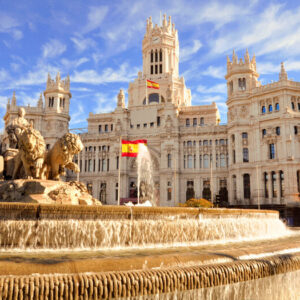Note that iPhone devices from Mainland China aren’t eSIM compatible. Also iPhone devices from Hong Kong and Macao aren’t compatible (except for iPhone 13 Mini, iPhone 12 Mini, iPhone SE 2020 and iPhone XS)
Spain is a country where history and modern life blend effortlessly. One moment you’re walking through medieval streets shaded by Moorish arches, and the next you’re enjoying inventive tapas in a stylish contemporary bar. Its diversity is striking – lush northern coastlines, sun-soaked Andalusian villages, royal Castilian cities, and Catalonia’s mix of culture and coastline all offer distinct personalities and traditions.
With landscapes ranging from the Pyrenees to the Mediterranean and Canary Islands, Spain feels like several countries in one. Each region reflects its own heritage, shaped by Romans, Moors, and centuries of evolving culture. Add in a famously relaxed lifestyle, vibrant festivals, and world-class food, and it’s easy to see why Spain continues to draw travelers seeking art, adventure, and authentic experiences. Whether you come for the architecture, the beaches, or the rhythm of everyday life, Spain invites you to slow down, explore deeply, and enjoy its many contrasts.
Must-Visit Destinations Across Spain
Spain is a country of contrasts, where world-famous icons stand alongside places that remain quietly authentic. Many journeys begin in major cities – some of the most inspiring options are highlighted in this list of cities to visit in Spain, but it’s often the smaller towns and rural landscapes that create the most lasting memories.
Stay Connected in Spain
Enjoy instant data access across cities without swapping SIM cards.
The Landmarks That Define Spain
Barcelona’s Sagrada Família remains Spain’s most iconic landmark, with Gaudí’s soaring design and stained-glass light. In Granada, the Alhambra showcases the beauty of Moorish architecture against the Sierra Nevada. Madrid’s Royal Palace reveals centuries of royal history, while Seville’s Cathedral and Giralda Tower dominate the city’s skyline. In Santiago de Compostela, the cathedral welcomes pilgrims completing the Camino.
The Hidden Corners Worth Seeking Out
Spain also offers gems far from the crowds. Albarracín’s pink medieval houses feel untouched by time, while the protected Cíes Islands boast some of Europe’s most pristine beaches. Ronda’s dramatic gorge, Las Médulas’ red-gold mining landscape, Setenil de las Bodegas’ cliffside homes, and the cinematic Tabernas Desert showcase the country’s diversity.
Balancing the Well-Known and the Unseen
The magic of Spain lies in combining both. Admire Gaudí’s masterpieces, then retreat to a quiet coastal village. Explore Madrid’s museums, then sip wine in La Rioja’s vineyards. Whether your trip focuses on architecture, nature, or culture, mixing iconic sights with hidden treasures reveals the true depth of Spain – a country proud of its landmarks and generous with its secrets.
Spain’s Food Culture and Vibrant Festivals
Food in Spain is about much more than eating – it’s a celebration of life. From a simple morning pastry to long, late-night dinners shared with friends, every meal is an occasion. Pair this with a year-round calendar of lively festivals, and it becomes clear how deeply food and celebration shape the Spanish lifestyle.
The Spirit of Tapas
Tapas are central to Spain’s culinary identity. These small plates – ranging from olives to garlic prawns—encourage sharing and slow, social dining. Each region adds its own twist: in Granada, tapas often arrive free with drinks, while in the Basque Country, pintxos offer creative bites served on bread.
Regional Specialities Worth Traveling For
Spain’s food traditions vary widely by region. Valencia is home to classic paella, Galicia is famed for its fresh octopus and shellfish, and Andalusia offers refreshing dishes like gazpacho and salmorejo. In Castile, slow-roasted suckling pig remains a beloved specialty. Many towns still preserve recipes handed down through generations, making Spain a paradise for food lovers – especially if you follow this ultimate travel guide to Spain’s cuisine, architecture, and culture.
Travel Across Spain Easily
One eSIM plan covers all your Spanish destinations seamlessly.
Markets and Food Halls
Markets offer a delicious window into local life. Madrid’s Mercado de San Miguel and Barcelona’s La Boqueria serve regional favourites, while smaller towns host weekly markets filled with seasonal produce, cheeses, and artisanal treats.
Spain in a Glass
Spain’s drinks are as diverse as its dishes. La Rioja and Ribera del Duero produce world-class wines, Catalonia is known for cava, and Jerez is the birthplace of sherry. While sangria is popular with visitors, locals often prefer tinto de verano – a lighter, refreshing wine spritzer.
Festivals That Fill the Streets
Spain’s festivals are unforgettable. Seville’s Feria de Abril bursts with colour and flamenco; Pamplona’s San Fermín brings global attention with the Running of the Bulls. Near Valencia, La Tomatina turns the town red with tomatoes, while Galicia’s Festa do Marisco celebrates its rich seafood culture. Barcelona’s La Mercè fills the city with concerts, parades, and fireworks.
How Food and Festivals Connect
Food and festivity go hand in hand in Spain. Many celebrations revolve around harvests – wine, olives, seafood – and each has its own traditional dishes. Pilgrimages like the Camino de Santiago highlight how meals shape the journey. In small villages, fiestas bring communities together over recipes passed down for generations. To travel Spain with an appetite is to experience the stories, heritage, and spirit behind every bite and celebration.
Making the Most of Your Trip to Spain

A trip to Spain is incredibly rewarding, and with a bit of smart planning, it becomes even smoother. Knowing when to visit, how to get around, and the customs that shape daily life helps you avoid common frustrations and fully enjoy the country’s beauty, flavours, and rhythms.
- Best Time to Visit Spain: Spain’s climate varies greatly. Inland cities like Madrid, Seville, and Córdoba can be extremely hot in summer, while the northern coast stays mild. Spring and autumn offer the best weather and fewer crowds, while winter is ideal for skiing or relaxed city sightseeing. If you’re planning around major festivals like Semana Santa or San Fermín, book accommodations well in advance.
- Getting Around Spain: Spain’s AVE high-speed trains connect major cities quickly and comfortably, while regional trains, buses, and budget airlines serve smaller towns and islands. For rural regions such as Andalusia or Galicia, renting a car provides flexibility to explore beaches, villages, and vineyards at your own pace.
- Accommodation Choices: Spain offers everything from luxury hotels to budget hostels, but its paradores – historic buildings turned into hotels – provide some of the most memorable stays. Apartments and Airbnb-style rentals are popular in cities, while casa rurales give a cosy, local experience in rural areas. Book early for summer hotspots like the Balearic Islands or Costa del Sol.
- Local Customs and Etiquette: Spaniards are warm and social, and understanding basic customs enhances interactions. Expect later mealtimes, casual greetings with handshakes or cheek kisses, and modest tipping. In small towns, greeting the bartender or shopkeeper is considered polite.
- Budgeting and Money Matters: Spain can suit any budget. Big cities are pricier, while small towns offer great value. Eating in local taverns or markets keeps costs low. Many museums offer free-entry days, and tip-based walking tours are affordable ways to explore. Credit cards are widely accepted, but carrying a bit of cash for small establishments is helpful.
- Staying Safe and Healthy: Spain is generally safe, though pickpocketing can occur in crowded tourist zones. Keep valuables secure and stay aware in busy areas. Tap water is safe to drink, and pharmacies are easily accessible. Reliable mobile data makes navigating, booking, and communicating much easier, giving you peace of mind as you explore.
How to Stay Connected Seamlessly While Traveling in Spain?
In Spain, having reliable mobile data can make the difference between a smooth trip and a stressful one. Whether it’s navigating Madrid’s streets, booking a last-minute train in Valencia, or translating a menu in Granada, being online keeps your plans running effortlessly.
An eSIM for Spain gives travelers instant activation and dependable coverage across Spain without the hassle of buying and swapping physical SIM cards. It works the moment you land, letting you call your hotel, load a map, or book a taxi straight away.
Spain’s diversity means you might visit bustling cities, remote beaches, or mountain villages on the same trip. Voye Global partners with top local networks, so your connection stays strong from Barcelona’s Gothic Quarter to the hills of Galicia. You can choose data plans that suit short getaways or longer adventures, and even keep your own number active for calls while using local data.
It’s not just about convenience – it’s also about safety. With quick access to maps, bookings, and emergency contacts, you’re never truly out of reach. And with an eSIM, there’s no queueing at kiosks or worrying about losing your home SIM card – just scan, activate, and travel.
Conclusion
Spain is a country that rewards curiosity. Its grand landmarks – from Barcelona’s Sagrada Família to the Alhambra of Granada – stand as testaments to centuries of artistry and ambition. Yet, just as compelling are its quiet corners: a medieval alley in Albarracín, the salt breeze on the Cíes Islands, or the hum of conversation in a neighbourhood tapas bar.
By blending the well-known with the less traveled, you experience the real Spain – a place where history, culture, cuisine, and community come together in everyday life. With thoughtful planning, flexible itineraries, and tools like a Voye Global eSIM to keep you connected, your journey can be as smooth as it is unforgettable.

Seamless Mobile Data Everywhere

















